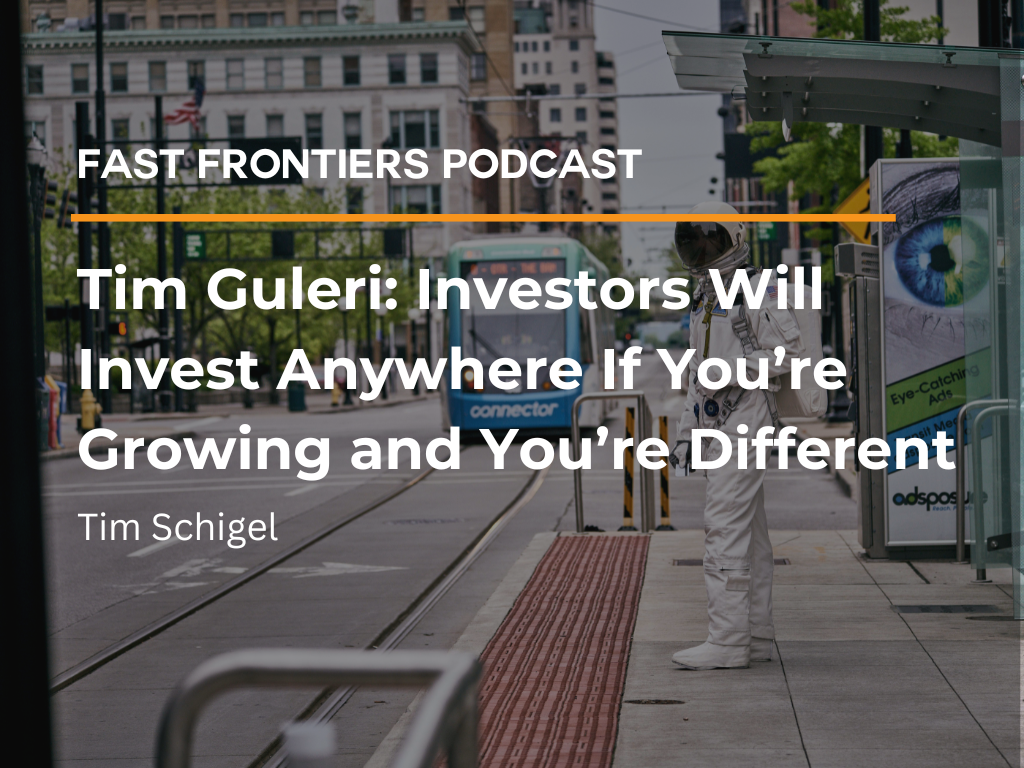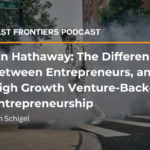Tim Guleri, Managing Partner of Sierra Ventures, is a former serial entrepreneur. Tim built two highly successful software infrastructure companies (Scopus Technologies and Octane Software) before joining Sierra Ventures in 2002, an endeavor focused on big data and artificial intelligence, where he has already managed to take two companies public (Sourcefire and MakeMyTrip). We sat down and chatted with Tim in Episode 4 of Fast Frontiers. We’d like to take a deeper dive today in a few more topics that we talked about then, among which include his expert insights on attracting investors from anywhere, not just the venture capitalist mecca of Silicon Valley.
Hi Tim. I’m excited to hear your thoughts on entrepreneurship and innovation in some of these, what [some may term], overlooked markets, [as well as] some insights that people would be surprised to know about investing in those markets.
“Sierra’s kind of been in business for 37 years, founded by my partner, Peter Wendell, who handed over the baton to myself, my partner Mark Fernandes, and Ben Yu in 2012. We are currently investing our 12th venture capital fund, so it’s safe to say that the firm, itself, is seeing many, many ups and downs in the economic cycle and has institutional memory on what works and what does a great company look like at inception, and what it looks like or needs to look like as [we] progress to the different milestones.” More on that later.
“[Particularly regarding what’s happening outside the Bay Area], because Sierra is an early-stage venture capital firm, we learned through the many decades in operation that you have to have a mindset that you cannot trap innovation in a geography. And that’s become even more of a theme in the last couple of decades. And certainly, [it’s been] helped by, and accelerated by, the emergence of cloud computing and SaaS, software as a service architectures that have been used to build great software companies, et cetera.”
Tim shared that Sierra even has a mantra of sorts that encapsulates their belief about (and zeal to have) thriving ventures, all of which can be unlimited by geographical locale: “Our view is very much have money, will travel.”
Tim then divulged that an impressive 68% of the fund’s dollars flow outside the Bay Area to find early-stage companies and then, in essence, act as the bridge into Silicon Valley because companies need a few vital things to grow: Expertise, Advice, and Capital. With the Bay Area having massive concentration of the capital, Sierra, through its network and relationships, can provide the other two necessary fundamental elements (expertise and advice).
“We really take the geographic boundaries off and [are then able to look] for the best investment in a particular sector and the best entrepreneur that’s building that particular company, and then try to invest in them and bring them, effectively, the playbook that we’ve launched through [my] being an entrepreneur, myself, and also what Sierra has done over the years.”
I remember when I was doing Cintrifuse and trying to help entrepreneurs connect with investors on the coast, I developed what I call the first principle, which is capital follows growth, which sounds really on track with what you’ve just shared. Can you elaborate?
Tim shared his own principle: “Investors will invest anywhere if you’re growing.” He then added: “The challenge you have when you’re in an overlooked market is you may have a great idea, you may have great talent, but that’s just not enough because [Valley investors] have that all around [them] in Silicon Valley.”
Tim then posed the challenge faced: “What is going to cause those investors to get on the airplane?”
But would you agree with that, that companies outside of your home region typically are going to need to have some compelling growth metric before you’re really going to be able to dig in?
Tim then shared how most investors need to see some solid evidence of a convincing growth metric, or you need to have an entrepreneur who has an exciting and compelling background (and experience) before they are willing to jump on board. He even offered a real-world example that he has seen of this at work in his own investment circle:
“I invested in a company out of Tokyo, again, in the data space called Treasure Data. And this is, again, a founding team, Kaz and Hiro, both of them were first-time founders, and they built this, effectively, this cloud data warehouse, which was a novelty, back six or seven years ago. Now, with all the Redshift and so forth with AWS and Bigtable from Google. These have become common artifacts in the cloud.”
Tim added: “Kaz’s background was a selling point, right? In this case, they didn’t have a massive open-source kind of dataset … but his background was so interesting, and what they built was so elegant, that that’s the thing that made me write the check.”
I’ll leave you with a final thought from Tim that helps sum everything up: “I think the lesson to the entrepreneurs is that having an idea is great. The foundational work that they have to do [is whatever it takes] to make them a unique investible opportunity as a great VC…. And that work has to be done by entrepreneurs, respectable whether you’re in the Bay Area or in Cincinnati or Tokyo, wherever.”
For more insights and advice from Tim, and all of our amazing season 1 guests, click here.



